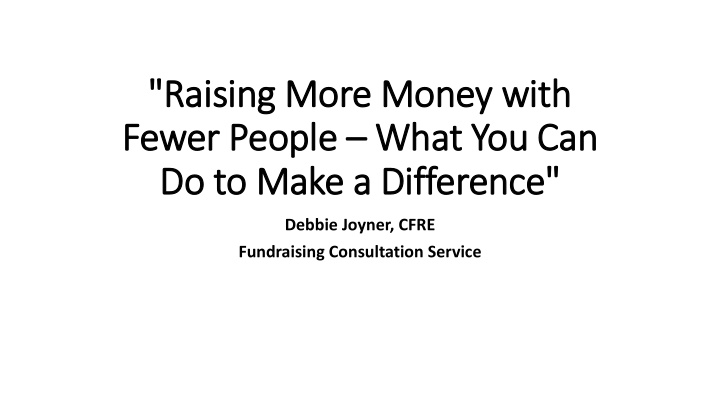



"Raising More Money wit ith Fewer People – What You Can Do to Make a Dif ifference" Debbie Joyner, CFRE Fundraising Consultation Service
Develop a Fundraising Plan • Set goals based on your organization’s budget • Determine how much do you need to raise • Divide your fundraising between • Major Donor Solicitations • Annual Giving/Appeals • Events • Grant writing • Don’t depend on Planned Giving to support budget – best used to establish a reserve or endowment fund
Engage your Board for Greater Im Impact • Build a board that is connected , committed , capable • Board members should be able to help you • Identify • Solicit • Thank • Make fundraising a board expectation • Every board member must contribute annually • Make the organization one of their top three giving priorities • Make a contribution that is generous in their household
Pareto’s Principle or the 80/20 Rule Roughly 20% of the invested input is responsible for 80% of the resulting output in any situation ― Vilfredo Pareto (1906) • Spend 80% of your time on 20% of your donors • 80% of your donations will come from 20% of your donors • Remember that 80% of all donations come from individuals NOT corporations • Spend time Identifying and meeting with your largest and most loyal donors (top 10 – 20%) • Talk 20% of the time and LISTEN 80% of the time!
Have the right systems in place • A CRM “customer relationship management” system is NOT optional • An excel or access spreadsheet is not enough • Don’t create your own system – many affordable systems available • Let the system work for you (segmentation, etc.) • Track EVERYTHING in your CRM • Donor meetings and communications • Family connections • Passions, interests, hobbies • Your memory may be great, but do it for the person who follows you
Focus on Donor Retention • It is more expensive to acquire new donors than to keep existing donors. • According to AFP research, over 70% of people who give to an organization never make another contribution. • The way you thank donors matters • Promptly and personally • Tell them how the gift impacted lives • Give the DONOR credit for the accomplishments of the organization • A donor thanked by a board member is 40% more likely to give again and more likely to follow up with a larger donation (Penelope Burke research)
Focus on Donor Retention • Donors who give over multiple years are likely to increase their giving • Donors who give for multiple years are more fully “engaged” • Do creative things that make your donors feel “special” • Donors who give long-term are your best Planned Giving prospects Calculate donor retention: # donors in a Year 1 # of donors from the same pool who gave in Year 2 Divide Year 2 # by Year 1# = Donor Retention Rate (%)
Schedule time for face-to to-face calls • Ask how the donor wants to communicate • Confirm that they want to see you periodically • Easy to let the “small tasks” take over • Remember to document the calls • Note interests, activities, family connections • Keep them informed about the impact of previous donations • Lay the foundation for future “asks” • Ask for advice! • Ask who else you should be talking to
Be strategic with events • Four per year works for me • One per season • Can target different audiences • Engage a committee – don’t do it alone! • Major donors who volunteer give much, much more! • Events are good way to engage new donors • Friend raising and fundraising • Easy to “touch” multiple donors • Make sure your board is also “working” the crowd!
Be strategic about soliciting businesses • Make a list of local businesses who: • Give to organizations similar to yours • Have a connection to someone at your nonprofit • Are located in your “neighborhood” • Your organization has done business with • Have a natural connection to your mission • Generally supportive of the community • Have an employee giving or volunteer program • Share your values
Be strategic about the grants you submit • Set priorities and stick to them • Develop a template • Only submit grants you have a good likelihood of winning • Develop an annual calendar with deadlines and reminders • Have someone who is not part of the process review
Use Your Time Wisely • Develop a Fundraising Plan • Engage your Board • Have the right systems in place • Focus on Donor Retention • Schedule time for face-to-face calls • Be strategic with events • Be strategic about soliciting businesses • Be strategic about the grants you submit
Thank you! Debbie Joyner, CFRE Fundraising Consultation Services 256.655.6690 www.FundraisingConsultationServices.com debbiejoyner@comcast.net
Recommend
More recommend